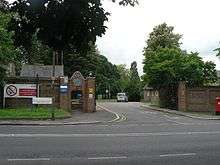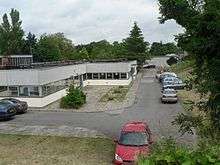Royal National Orthopaedic Hospital
- This page is about the hospital in Greater London. For the hospital in Birmingham, England; see Royal Orthopaedic Hospital.
| Royal National Orthopaedic Hospital | |
|---|---|
| Royal National Orthopaedic Hospital NHS Trust | |
| Geography | |
| Location | Stanmore, Greater London, United Kingdom |
| Organisation | |
| Care system | NHS |
| Hospital type | Specialist |
| Affiliated university | University College London |
| Services | |
| Emergency department | No |
| Beds | 220 |
| Speciality | Orthopaedic Surgery |
| History | |
| Founded | 1905 |
| Links | |
| Website | http://www.rnoh.nhs.uk/ |



.jpg)
The Royal National Orthopaedic Hospital (informally the RNOH) is a specialist orthopaedic hospital located in Greater London, United Kingdom and a part of Royal National Orthopaedic Hospital NHS Trust. It provides the most comprehensive range of neuro-musculoskeletal health care in the UK, including acute spinal injury, complex bone tumour treatment, orthopaedic medicine and specialist rehabilitation for chronic back pain.[1] The RNOH is a major teaching centre and around 20% of orthopaedic surgeons in the UK receive training there.[1]
History
The Royal National Orthopaedic Hospital NHS Trust (RNOH), based in Brockley Hill, Stanmore and Bolsover Street, central London, is a National Centre of Excellence, which treats patients from across the UK, many of whom have been referred by other hospital consultants for second opinions or treatment of complex or rare conditions. Patients are also referred to the hospital from many other parts of the world.
The RNOH was founded in 1905 with the amalgamation of London's three specialist orthopaedic hospitals and can thus trace its history back to 1838.
The hospital is located on two sites. The main site, the 'country branch', is located in 112 green belt acres at Stanmore with the 'town branch' located on Bolsover Street, central London. The town branch was also located at 234 Great Portland Street until 1984.
During the First World War, the hospital became an emergency hospital for the military and in early 1918 also housed discharged disabled soldiers. King George V and Queen Mary visited the hospital on two occasions.
1920 saw the start of an hospital funds appeal, with the first annual fundraising day 'Buttercup Day' being launched by HRH the Duke of Gloucester, Patron of the RNOH.
In the 1930s the hospital became known as the leading centre for the treatment of poliomyelitis and tuberculosis and in 1936 the building of the Stanmore Cripples Training College was started.
The RNOH was at the forefront of significant advances in the treatment of orthopaedic conditions in the first quarter of the twentieth century. Advances in scientific investigations made the diagnosis of disabling conditions more accurate, and often at an earlier stage in the patients illness. This meant that patients for whom there would be no possible cure then had the opportunity to be relieved of their pain and deformity.
The RNOH saw the outbreak of the Second World War with many Nissen-type huts being erected to house civilian orthopaedic cases and casualties. Patients were brought from across the country, including those from hospitals near the coast, areas close to airfields and other military installations.
In 1945, the RNOH was recognised as a postgraduate teaching hospital and it was recommended that an Institute of Orthopaedics should be founded and that it should be associated with the RNOH. With the formation of the Institute came a joint appointment between the two centres, that of Mr Herbert Seddon, who in 1964 was awarded a Knighthood for his work in Orthopaedics.
1948 saw the start of the National Health Service from which time the RNOH became an independent teaching hospital.
In 2016 Norman Sharp, a 91 year old British man, was recognised as having the world's oldest hip replacement implants. The two vitallium implants had been implanted here in November 1948. The 67 year old implants had such an unusually long life, partly because they had not required the typical replacement of such implants, but also because of Mr Sharp's young age of 23 when they were implanted, owing to a childhood case of septic arthritis.[2] The RNOH's work into orthopaedic care continued when in 1950 the hospital moved into the treatment of scoliosis, back care, leg inequality, hand and peripheral nerve injuries.
Training and research has played an important part in the hospital's work, resulting in the development of dedicated units, the training and teaching of consultants overseas as well as UK medical students and nurses.
In 1979, HRH The Prince of Wales opened a Rehabilitation Assessment Unit, built with funds raised by the British Motor Racing Drivers Association, in memory of Graham Hill who had once been a patient of the hospital and a Council member of the Friends.
Following years of research and treatment into spinal injures, the RNOH opened a spinal injuries unit, one of the first of its kind. The London Spinal Unit was officially opened by HRH the Princess of Wales in 1984.
Activities
As a national centre of excellence, the RNOH treats patients from across the country, many of whom have been referred by other hospital consultants for second opinions or for treatment of complex or rare conditions. It is closely associated with University College London (UCL) and the UCL Institute of Orthopaedics and Musculoskeletal Science occupies the same site. Other research departments connected with the RHOH include the Centre for Disability Research and Innovation, the Institute of Human Performance and the Centre for Biomedical Engineering. The Trust also works closely with other hospitals and has many joint appointments with other Trusts to ensure maximum availability of specialist skills for patients. Patients of the Trust also benefit from access to the ASPIRE (Association for Spinal Injury Research, Rehabilitation and Reintegration) National Training centre which is located on site and hosts sporting and other facilities for able-bodied and disabled people.
Performance
It was named by the Health Service Journal as one of the top hundred NHS trusts to work for in 2015. At that time it had 1310 full-time equivalent staff and a sickness absence rate of 2.88%. 87% of staff recommend it as a place for treatment and 71% recommended it as a place to work.[3]
It expects to lose £15.2m in income, 11% of its turnover during 2016-17 under changes to the NHS tariff, more than a 25% of what it received last year for inpatient work.[4]
Notable staff
- Audrey Smith (1915-1981), cryobiologist
- Sir Herbert Seddon, Orthopaedic Surgeon and author of 'Surgical Disorders of the Peripheral Nerves'
See also
References
- 1 2 "Britain's best hospitals: A patients' guide". The Independent. 20 March 2008. Retrieved 3 June 2011.
- ↑ "Former RNOH patient has world's oldest hip replacements". Royal National Orthopaedic Hospital. 21 March 2016.
- ↑ "HSJ reveals the best places to work in 2015". Health Service Journal. 7 July 2015. Retrieved 23 September 2015.
- ↑ "NHS orthopaedic hospitals warn of funding crisis due to payment changes". Guardian. 29 October 2015. Retrieved 30 October 2015.
External links
| Wikimedia Commons has media related to Royal National Orthopaedic Hospital. |
- The Royal National Orthopaedic Hospital NHS Trust
- UCL Institute of Orthopedics and Musculoskeletal Science
- UCL School of Life & Medical Sciences
- University College London
Coordinates: 51°37′55″N 0°18′18″W / 51.632°N 0.305°W